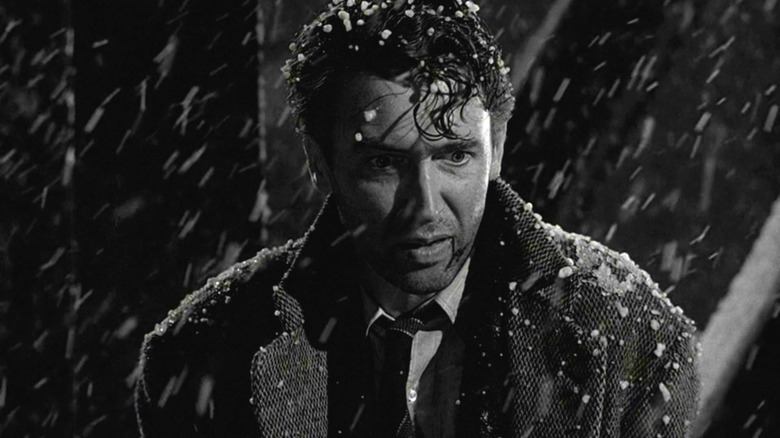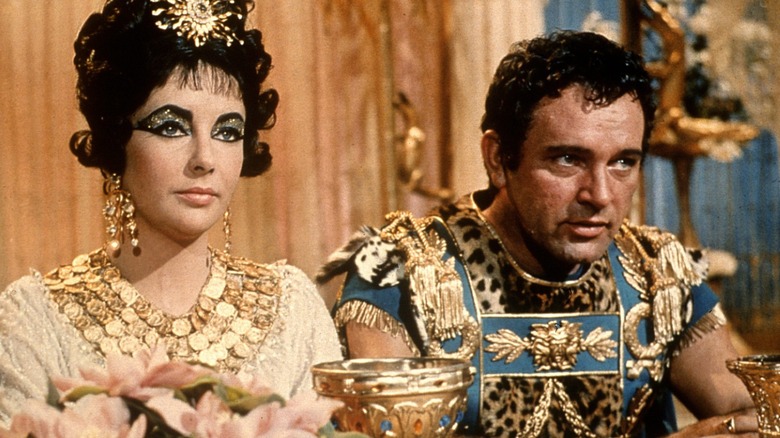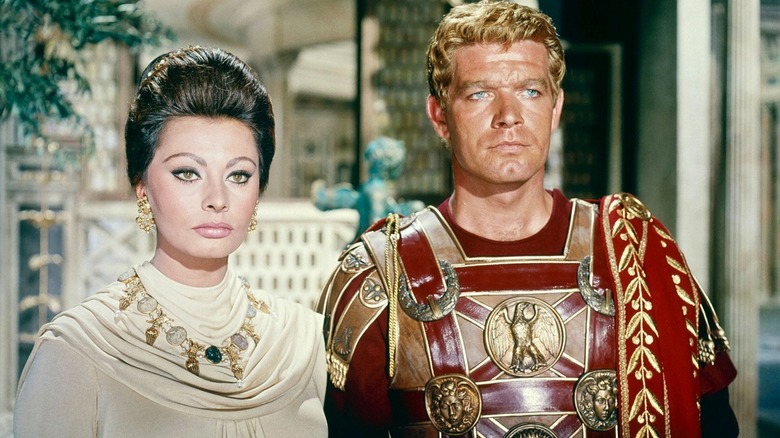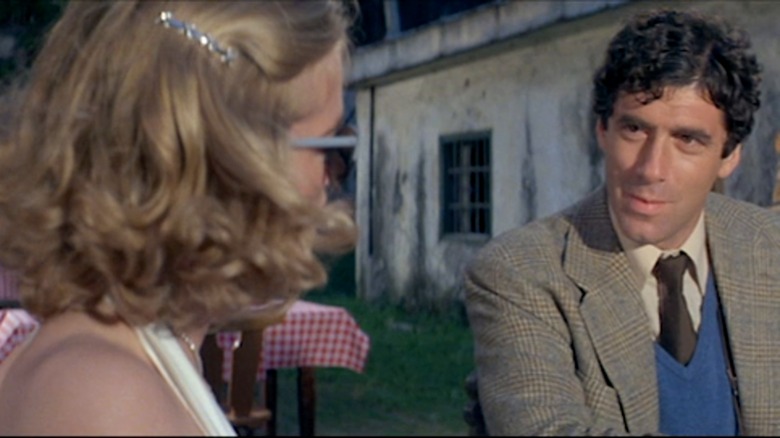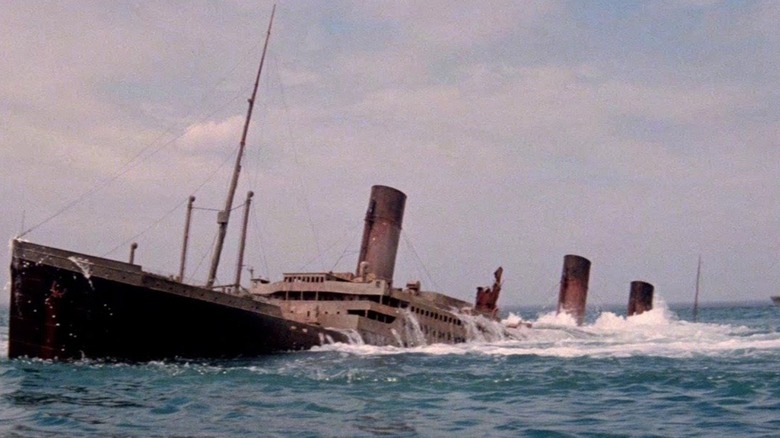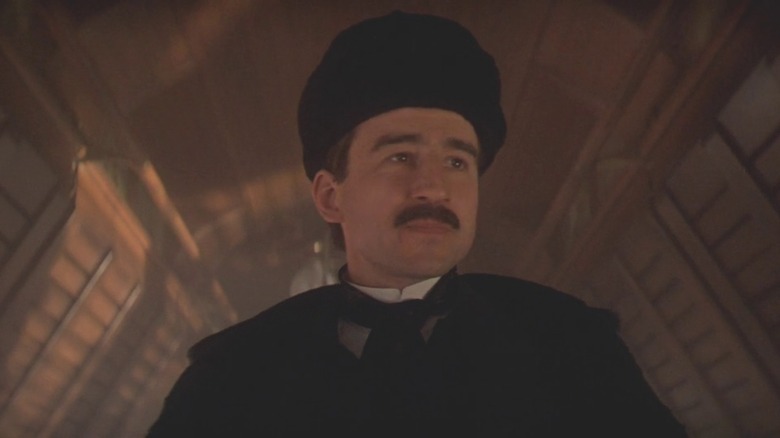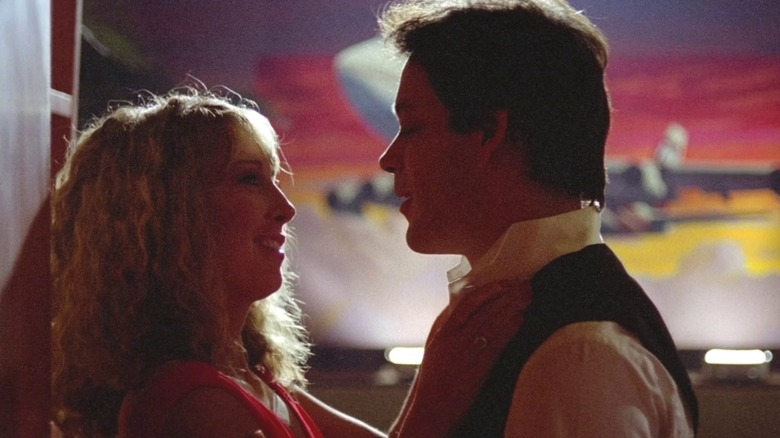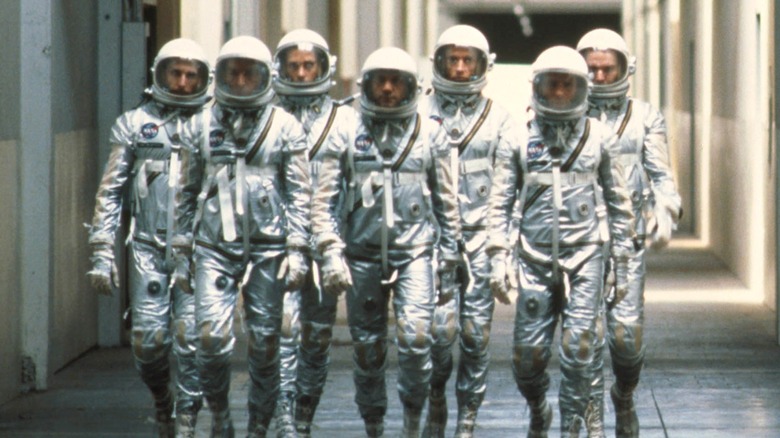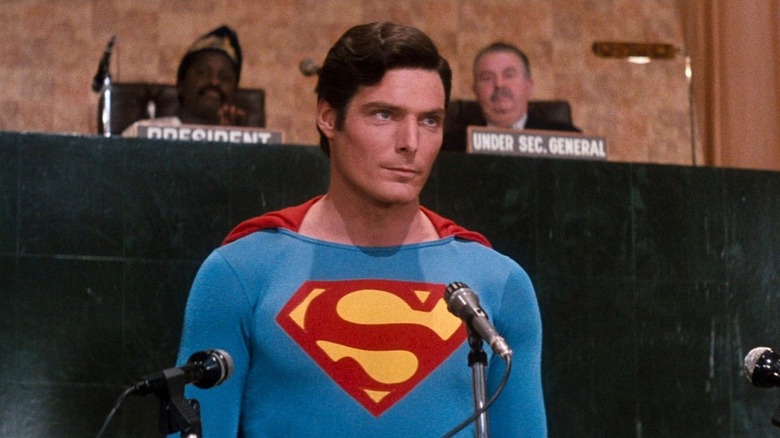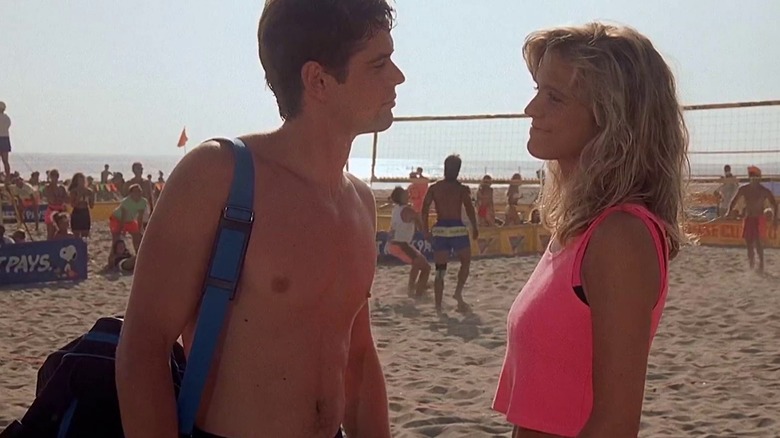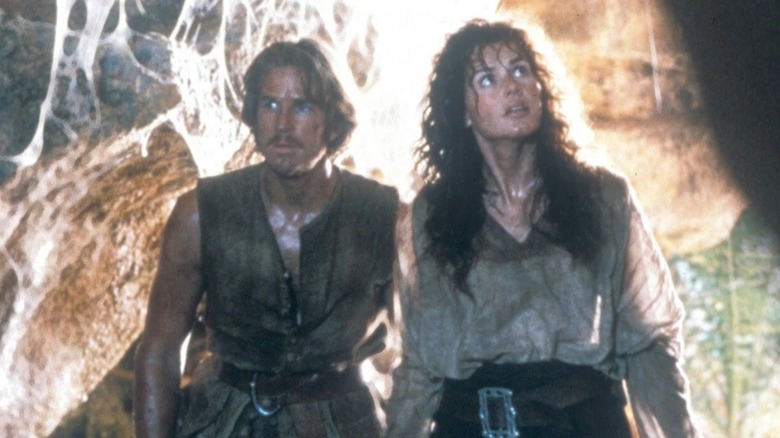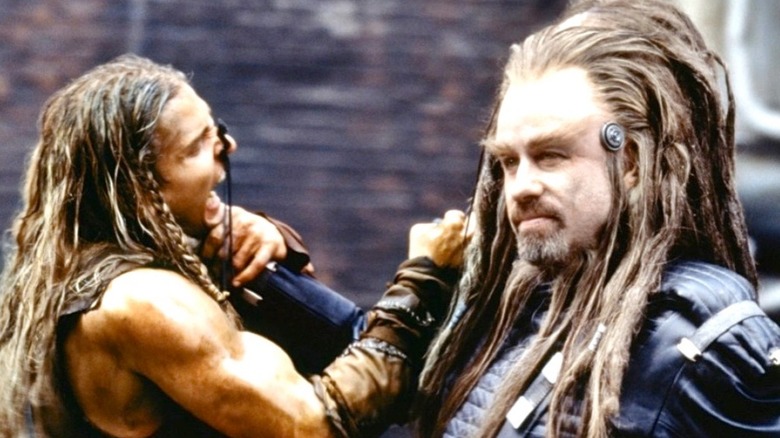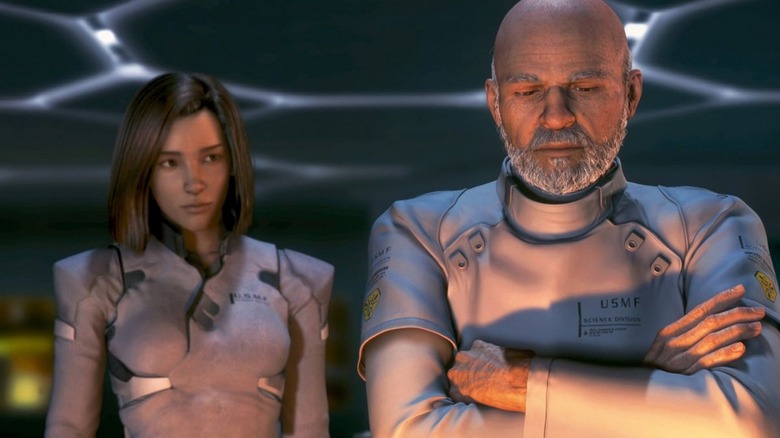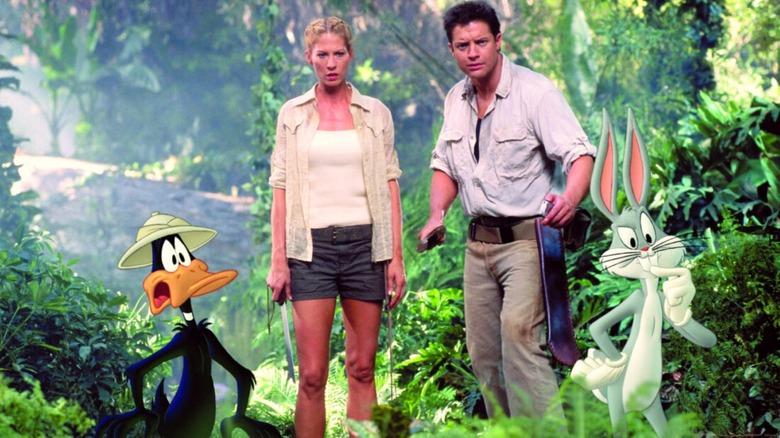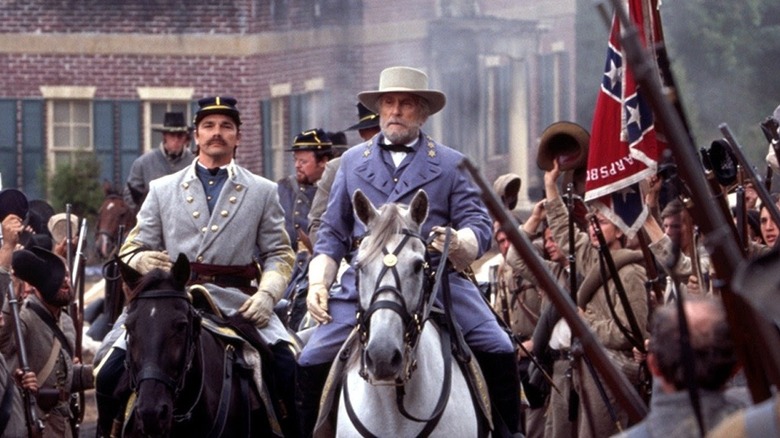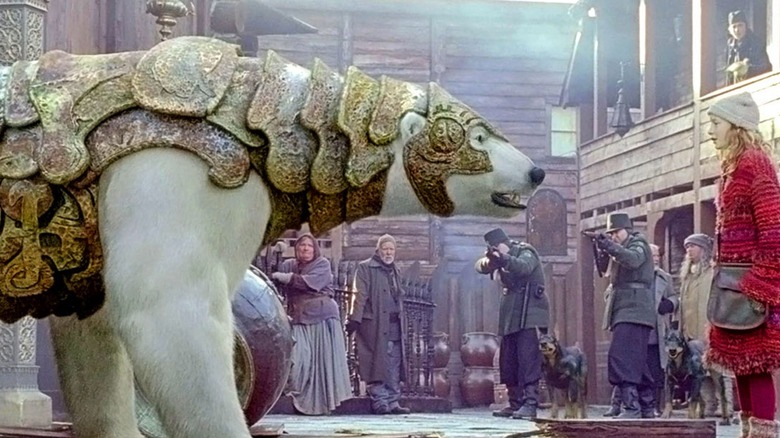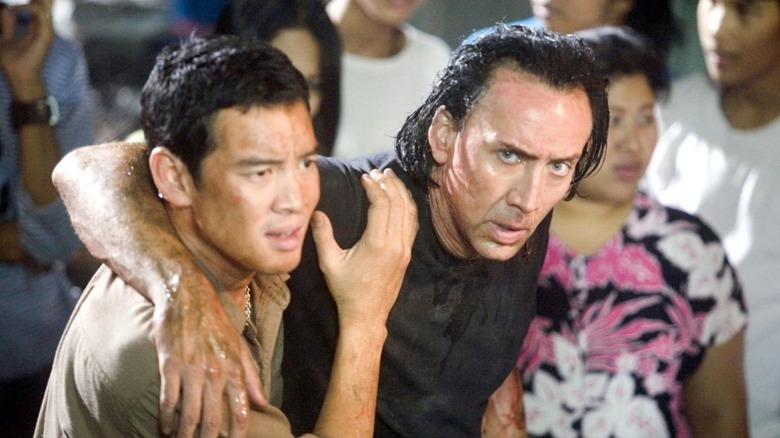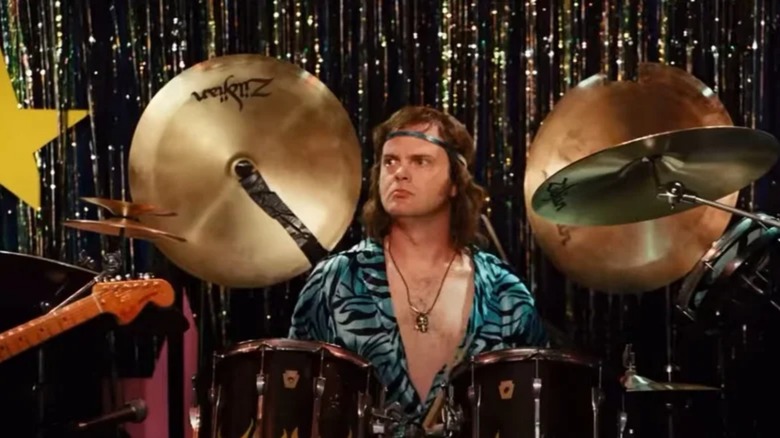20 Movies So Bad They Killed The Studios That Made Them
It may not seem like it, but making movies is a risky business. Even going back to the medium's beginning, it costs an exorbitant amount of money to bring a film from the idea phase to something people pay to see. These days, little has changed, and studios often cough up tens or even hundreds of millions to see a movie produced, distributed, and marketed, so there's a lot of cash riding on whether or not a film does well.
Even when a movie makes gobs of money, many fall short of their break-even point. If a studio pays $100 million to make a film, the break-even point is often double or even 2.5 times the production budget due to marketing and distribution costs. So even when a film appears to do well, that doesn't always mean the studio fatcats will be laughing their way to the bank — a lot of movies actually lose the studios money.
Often, studios can make these losses up via streaming and other means. But occasionally, a box office bomb is so bad that the studio behind it has little option but to shut its doors. This has happened several times over the past century or so, and some do so poorly that they tank the studios that made them. It doesn't happen often, but each of these films took their studios down with them, and some may surprise you.
It's a Wonderful Life -- Liberty Films
Believe it or not, "It's a Wonderful Life" wasn't always a beloved Christmas masterpiece. The film is a defining Frank Capra classic starring James Stewart as George Bailey, a man at the end of his rope who's ready to cash it in, when his guardian angel shows him all the people he's helped and what life would be like without him. It's a ubiquitous Christmas movie that's broadcast every year and is often on lists of the greatest films ever made, though that wasn't always the case.
Liberty Films produced the film for $2.3 million ($36 million when adjusted for inflation), and when all was said and done, it made only about $2 million at the box office. Liberty was founded by legendary filmmakers Capra, William Wyler, and Samuel J. Briskin two years earlier, making "It's a Wonderful Life" the studio's first film. The initial plan to produce 15 pictures ran afoul with reality, and Liberty couldn't cope with the financial loss.
When "It's a Wonderful Life" bombed at the box office, it took the studio with it. Facing foreclosure, Liberty sold its assets to Paramount Pictures and shut its doors. The three founders cashed Liberty and its assets in for Paramount stock and took jobs at the studio. Despite its financial failure, "It's a Wonderful Life" was nominated for five Academy Awards, including best picture and best director.
Cleopatra -- 20th Century Fox
In 1963, 20th Century Fox rolled the dice on an epic starring Elizabeth Taylor, Richard Burton, Rex Harrison, and Martin Landau. "Cleopatra" wasn't the first attempt at telling the story of the Queen of Egypt, but it was undoubtedly the biggest. Fox produced the film for $44 million in 1963 ($439.5 million when adjusted for inflation), making "Cleopatra" the most expensive film in history up to that point. Part of the costs resulted from a problematic shoot requiring changing the director, a scandalous affair between Burton and Taylor that resulted in a lawsuit, and numerous reshoots.
Initially, the film was to cost around $2 million, which ballooned to $5 million and kept going. Taylor took on the title role for $1 million, placing her in the same camp as Marlon Brando and nobody else — unheard of at the time. Taylor also insisted the filming take place internationally, costing more and adding to the problematic set builds and other issues. Ultimately, "Cleopatra" became a notorious box office bomb despite being the highest-grossing film of 1963.
Essentially, "Cleopatra" cost Fox too much to make, market, and distribute. Fox had to sell 300 acres of its Los Angeles back lot (which is now Century City, California) to cover costs. While 20th Century Fox did not shut its doors permanently, the film bears mention due to the damage "Cleopatra" did to the studio's bottom line and its reputation.
The Fall of the Roman Empire -- Samuel Bronston Productions
The 1960s was a great decade for Hollywood epics, but not all of them performed as well as some from the previous 10 years, like "Ben-Hur" and "The Ten Commandments." Still, the decade plowed on with several notable titles, including "The Fall of the Roman Empire," starring Sophia Loren, Alec Guinness, James Mason, Stephen Boyd, Christopher Plummer, Omar Sharif, and Mel Ferrer.
The film's title gives away the plot, as it's a loose adaptation of Edward Gibbon's "The History of the Decline and Fall of the Roman Empire." The one thing the film had going for it in the beginning was Charlton Heston, who was all but a requirement for an epic to work. Unfortunately, he backed out before production began, leaving Boyd to take the role of Livius in his stead. Like any epic, costs were high, amounting to $19 million, or about $187 million today.
Unfortunately, the box office wasn't kind, totaling only around $4.75 million. Samuel Bronston produced "The Fall of the Roman Empire" via his company, Samuel Bronston Productions, which didn't survive the massive loss. The company ceased business in 1964, the same year the film was released, and entered into bankruptcy. Bronston was convicted of perjury as a result of the proceedings and took it to the Supreme Court, which ultimately sided with Bronston.
The Lady Vanishes -- Hammer Films
Hammer Films was once the preeminent production house for Gothic horror movies. The studio churned out tons of classics, beginning in the 1930s and continuing well into the '60s and '70s. The 1970s saw a downfall of both Hammer and the horror genre, which had become oversaturated with cheap-to-produce similar content. Hammer's tried-and-true formula began to falter, and the studio produced a string of financial failures, ending with "The Lady Vanishes."
A remake of Alfred Hitchcock's 1938 film of the same name, the movie was a risky proposition to begin with. It's challenging to do as well or even better than a master filmmaker like Hitchcock, and Hammer learned this lesson the hard way. The remake starred Elliott Gould and Cybill Shepherd, and was an absolute bomb. The studio paid around £2.5 million to produce, or just under $20 million in today's dollars; while the box office numbers aren't available, it couldn't have been good.
Hammer didn't entirely disappear after the release of "The Lady Vanishes," but it did stop producing movies. It was the last film the company made until 2008's "Beyond the Rave." The studio liquidated in 1979 but technically remained in existence, and has been bought and sold many times over the years. Hammer, like its oft-revisited subject, Dracula, seems to have survived its death and continues producing content after again being given a new life.
Raise the Titanic -- ITC Entertainment
James Cameron's "Titanic" may be the most well-known film about the doomed ocean liner, but it's hardly the first. The RMS Titanic has been a source of speculation and intrigue since the ship went down, and it's been the focus of numerous films. One of the most expensive was "Raise the Titanic," based on Clive Cussler's novel of the same name. The plot centers around recovering the ship to obtain precious cargo hidden inside.
The film was released about five years before the actual wreck was discovered, but it makes some reasonable assumptions. The film cost ITC Entertainment around $40 million to produce, which wasn't even remotely recovered. The picture's box office haul amounted to around $7 million, which didn't even pay for the 55-foot-long scale replica that weighed in at a whopping 10 tons, costing $5 million to construct, and the $3.3 million tank to hold it. Lew Grade, the film's producer, told the Independent years later, "It would be cheaper to lower the Atlantic than raise the Titanic."
"Raise the Titanic" was the last in a long line of stinkers ITC Films and its distributing arm, Associated Film Distribution, released. ITC had to sell AFD and the distribution rights of its library to Universal Pictures. ITC remained in existence, though the company was forced to sell more of its assets over time, ultimately moving primarily into television distribution before shutting its doors for good in 1998.
Heaven's Gate -- United Artists
Director Michael Cimino stormed into popularity with 1978's "The Deer Hunter," earning Academy Awards for best picture and best director. Two years later, he followed up his massive win with "Heaven's Gate," almost completely quashing all the positive buzz he'd acquired. "Heaven's Gate" is about a dispute involving immigrants and land barons in 1890s Wyoming. The film features an all-star cast, including Christopher Walken, John Hurt, Kris Kristofferson, Sam Waterston, Jeff Bridges, and many other notable actors.
The shoot ran into problems almost immediately, and an initial budget of $7.5 million shot up to $11.6 million. By the end, Cimino managed to bloat the budget to a whopping $44 million. Cimino's on-set behavior made him a literal tyrannical dictator, bringing negative attention to an already difficult shoot. Numerous takes and retakes upped the budget, and after the first five days of shooting, "Heaven's Gate" was already six days behind schedule.
Eventually, Cimino finished his project and unleashed it upon the world. "Heaven's Gate" was not liked by critics, and audiences avoided it like the plague. The film made less than $4 million at the box office, significantly damaging United Artists' bottom line. The longstanding independent studio, co-founded in the 1920s by Charlie Chaplin, became a subsidiary of MGM, effectively ending its status as a standalone film company.
One From the Heart -- Zoetrope Studios
Francis Ford Coppola is arguably one of the greatest directors of his generation, but not all of his work has been a critical and commercial success. "One From the Heart" takes place in Las Vegas, where a couple breaks up, finds comfort elsewhere, and ultimately returns to one another. It's a musical, and it's entirely different from Coppola's other work.
Coppola bought the rights to the property through his company, Zoetrope Studios, and personally financed the film, first for $15 million, but ultimately at a cost of $25 million ... for a romantic comedy released in 1982. Coppola's insistence on using expensive miniatures and sets cost much more than a typical musical rom-com. The film utterly bombed with critics and audiences, making only $636,796 at the box office. This left Coppola indebted to Chase Manhattan Bank and others for $30 million.
Coppola had no choice but to file for bankruptcy — the third time the director had to do so in less than a decade. His personal finances were mixed with Zoetrope's, costing Coppola a great deal. Zoetrope Studios didn't die entirely due to the "One From the Heart" debacle, but it upended Coppola's finances for over 10 years. Zoetrope Studios lost all the good favor earned via "Apocalypse Now" and "The Godfather" films, ultimately giving way in 1990 to Coppola's other studio, American Zoetrope.
The Right Stuff -- The Ladd Company
There's no denying that "The Right Stuff" is an excellent film. The movie focuses on the founding of the American space program and the Mercury Seven, the first batch of test pilots shot into space in the 1960s. The film's stellar cast includes Sam Shepard, Scott Glenn, Ed Harris, Fred Ward, Dennis Quaid, Barbara Hershey, and many others. "The Right Stuff" also earned significant critical acclaim, winning four of eight Academy Awards.
Despite all it had going for it, "The Right Stuff" bombed at the box office. The film cost $27 million and made less than $22 million. "The Right Stuff" had a lot of competition upon release, and its sizeable length of nearly 200 minutes didn't help bring audiences to theaters. The Ladd Company produced the film, which was the last in a long line of financial failures the company released up to that point.
After "The Right Stuff" tanked, Warner Bros. ceased releasing films by The Ladd Company, forcing the studio to search for new distribution. The studio continued with limited releases and worked intermittently with Paramount Pictures and Miramax Films before closing its doors for good in 2007. Losing its contract with Warner Bros. was the most significant impact "The Right Stuff" had on the company, and it never fully recovered.
Superman IV: The Quest For Peace -- Cannon Films
"Superman: The Movie" was an immensely successful superhero film that proved live-action to be an acceptable medium for the genre. The sequel, 1980's "Superman II," was equally impressive, but the franchise began to decline with the third film. Finally, there was "Superman IV: The Quest for Peace," which was an arguably crummy movie. The film sees Superman rid the world of its nuclear arms by throwing them into the sun, only for Lex Luthor to unleash an evil solar-powered clone of the Man of Steel.
The Cannon Group, Inc. was behind the film's production, which didn't go well. The company suffered a financial crisis in mid-production from taking on too many projects simultaneously. This resulted in budget cuts requiring 30 minutes of footage being dropped from the film, which suffered as a result. "Superman IV" made $36.7 million on a budget of $17 million, which was cut down from $30 million. Despite doubling its cost at the box office, the film lost money and was critically panned.
At the same time, Cannon invested millions in a live-action adaptation of "Masters of the Universe," which also bombed commercially and critically. Cannon faced bankruptcy and an investigation by the SEC., ultimately forcing its sale to Pathé Communications. It soon fell under the ownership of MGM, but an attempted revival resulted in failure, and the studio became defunct in 1994. It was revived once more as New Cannon, Inc., and finally, Cannon Films.
Side Out -- Aurora Productions
Aurora Productions began producing content in the early '80s with the incredibly successful and much-loved animated classic "The Secret of NIMH." Unfortunately, the production company followed this with a string of live-action flops, and not a single one of them made much money. Aurora paid millions to produce five movies you've likely never heard of before: "Heart Like a Wheel," "Eddie and the Cruisers," "Maxie," "Eddie and the Cruisers II: Eddie Lives!," and finally, "Side Out."
"Side Out" was the last movie that Aurora produced before closing its doors for good. The film is about a law student named Monroe Clark (C. Thomas Howell), who moves to Southern California and winds up competing in a volleyball tournament. Filming coincided with the Miller Lite USA Championships, a two-day $150,000 tournament. The film features numerous professional volleyball athletes, which is, unfortunately, the most noteworthy thing about "Side Out."
The film cost around $6 million to produce, and it raked in around $450,000. The financial loss was too significant for Aurora Productions to overcome, and it completely discontinued operations in 1990, shortly after the film hit theaters. While Aurora is no longer operational, "Side Out" received a Retro VHS Blue-ray release in 2022, though this was likely through the film's distributor, TriStar Pictures.
Cutthroat Island -- Carolco
"Cutthroat Island" was notoriously named the biggest box office bomb of all time by Guinness World Records, a dishonor it held until at least 2012 (more recent contenders include "The Flash" and "John Carter"). That's neither an insignificant nor desired achievement, but the film earned it all the same. "Cutthroat Island" was intended to be a tentpole film, but instead of rekindling interest in the swashbuckler genre, it effectively killed it for nearly a decade. The film stars Geena Davis and Matthew Modine in a surprisingly dull attempt at a pirate movie.
"Cutthroat Island" suffered numerous problems, including Michael Douglas' backing out and Modine taking his role. Incredibly expensive sets of wooden sailing ships were constructed and then rebuilt. The initial budget of $60 million, which was high already, increased to nearly $100 million by the shoot's end. On top of all the production nightmares that hampered filming, critics tore the film apart, hindering the careers of everyone involved.
Carolco hoped the movie would succeed and help eliminate its numerous debts, but the opposite happened. Carolco ultimately lost an estimated $147 million via "Cutthroat Island," utterly destroying the company. Carolco agreed to sell its assets to 20th Century Fox for $50 million. That deal fell through when Canal Plus outbid Fox. In the end, "Cutthroat Island," which was meant to save Carolco from financial ruin, dug a much deeper hole and walked the production company right off the plank into bankruptcy and oblivion.
Titan: A.E. -- Fox Animation
Director and animator Don Bluth's work has entertained children and adults for decades, but his final theatrical film failed to perform as well as "The Secret of NIMH," "The Land Before Time," and his other well-received movies. "Titan A.E." was an ambitious project, incorporating traditional hand-drawn 2D cel animation with extensive CGI — a relatively new technology in 2000. The film follows Cale Tucker (voiced by Matt Damon) as he's swept up in interstellar affairs related to the destruction of Earth and humanity's last hope for salvation and survival.
"Titan A.E." received positive buzz for its visual style, but mixed reviews didn't help it when it hit theaters. The film was the third and final film produced by Fox Animation, which previously released Bluth's "Anastasia" and "Bartok the Magnificent." Due to the increased costs of incorporating burgeoning technology with the tried-and-true animation methods of the 20th century, the film cost $75 million to produce, which was a lot back then for an animated movie.
While "Titan A.E." has plenty of fans and has since become something of a cult classic, it bombed at the box office with only $36.7 million in ticket sales. 20th Century Fox killed its animation studio, which was developing a film set in the Ice Age. When operations ceased, some at Fox approached Blue Sky Studios and developed the film that would launch the "Ice Age" franchise, so some good came from Fox Animation's demise.
Battlefield Earth -- Franchise Pictures
John Travolta's desire to adapt L. Ron Hubbard's "Battlefield Earth" into a film began in the 1990s, and he took it to numerous studios. They all balked at the film's connection to Scientology, with the project ultimately landing at the independent production company Franchise Pictures. The film is about a human-led rebellion against an alien race called the Psychlos 1,000 years after their conquest of Earth, and it stars Travolta, Barry Pepper, and Forest Whitaker.
"Battlefield Earth" was an ambitious picture, to say the least, and it cost $80 million to create. In the end, it flopped hard, taking in less than $30 million in ticket sales, while the Razzie Awards handed the film the Golden Raspberry for "worst drama of [the Razzies'] first 25 years." The film is regarded as absolutely terrible, but Travolta stands by it.
Regardless, it was a failure, resulting in Franchise Pictures owing its investors far more than it had in its coffers. A lawsuit found the company overstated the budget by millions. Franchise Pictures lost its court battle and was ordered to pay Intertainment $77 million, though the jury rejected Intertainment's claim under the RICO statute. "Battlefield Earth" has since become a cautionary tale about independent passion projects.
Final Fantasy: The Spirits Within -- Square Pictures
"Final Fantasy" has long been one of the best role-playing video game franchises of all time. When the series' creator, Hironobu Sakaguchi, set out to direct a computer-animated film based on the franchise, fans' excitement was palpable. This was the original creator branching out into a new medium, and fans were eager to see the result. Sakaguchi used Square Pictures to render the film, and the result was the first genuinely photorealistic computer-animated film ever made.
While "Final Fantasy: The Spirits Within" is arguably a beautifully rendered movie, it was not well received. The movie's cost also increased exponentially, amounting to a whopping $145 million — one of the most expensive video game films to date. The film made a relatively tidy sum of $85 million, but it was far below its cost, making "The Spirits Within" a box-office bomb.
At the time of its release, Square and Enix planned to merge, but Enix held off following Square's significant financial loss. They ultimately joined in 2003, becoming Square Enix, but Square Pictures didn't survive "The Spirits Within." Before shutting down for good, Square Pictures fulfilled a commitment to create a 10-minute segment featured in "The Animatrix." Once finished, the studio laid off its 125 employees located in Hawaii, Japan, and North America.
Looney Tunes: Back In Action -- Warner Bros. Feature Animation
In 1996, Warner Bros. blew audiences away with "Space Jam," proving the studio could incorporate live-action and animation into a successful feature film. Since it did well, it was no surprise that the studio would want to follow up that success with another, and in 2003, "Looney Tunes: Back in Action" hit theaters. The film cost $80 million, just as much as its predecessor. Unfortunately, it didn't do nearly as well at the box office.
While "Space Jam" took home over $230 million, its successor only managed to rake in $68.5 million. Initially, the plan was to make a sequel to "Space Jam," though that didn't happen until 2021, resulting in another box office bomb. Still, the 2003 release of "Back in Action" suffered from changes made throughout production, ensuring that the final product looked nothing like the original intention. The film didn't blow anyone away, and led production to cease at Warner Bros. Feature Animation.
Warner Bros. Feature Animation canceled the projects it was developing following the financial loss from "Back in Action" and went defunct in 2004. Warner Bros. later reorganized its animation pipeline and relaunched it as Warner Animation Group, which produced "The Lego Movie," "Tom and Jerry," and "Space Jam: A New Legacy." The division was rebooted again in 2023 by Warner Bros. Discovery, this time as Warner Bros. Pictures Animation.
Gods and Generals -- Ted Turner Pictures
Epic war movies are often excellent, but can be somewhat cumbersome. 2003's adaptation of Jeffrey Shaara's novel, "Gods and Generals," is one such film, as it's 219 minutes long (280 for the director's cut). The film is a prequel to director Ronald F. Maxwell's 1993 "Gettysburg," and it booked an all-star cast, including Jeff Daniels, Robert Duvall, and Stephen Lang. The first cut of "Gods and Generals" exceeded five hours, requiring significant edits.
Despite the trimming, the film's pacing is an insurmountable hindrance — it's a slog, to be sure, and there's a six-hour miniseries cut as well. The film was a financial and critical failure despite a great deal of historical accuracy, brilliant acting by the leads, and incredible costumes. In scope, "Gods and Generals" is an impressive prequel to "Gettysburg," but it couldn't overcome its encumbrances.
After failing to garner interest elsewhere, Ted Turner financed the film via his own Ted Turner Pictures. This put the $90 million production, marketing, and distribution cost on Turner, who lost it all. The film brought in just under $13 million, ensuring Ted Turner Pictures was a "one and done" company. When the film failed, Turner pulled the plug on an adaptation of "Last Full Measure," the third film in the trilogy. Ultimately, "Gods and Generals" was the only film made by Ted Turner Pictures.
The Golden Compass -- New Line Cinema
New Line Cinema astounded the world with its mind-blowing adaptation of J.R.R. Tolkien's "The Lord of the Rings" trilogy, and the studio continued adapting high fantasy. Shortly after "The Fellowship of the Ring" hit theaters, New Line acquired the rights to Philip Pullman's "His Dark Materials" trilogy and developed the first adaptation as "The Golden Compass." Like Tolkien's work, Pullman's presented several challenges, one of which was cost, as the world Pullman describes is vast, magical, and highly detailed.
"The Golden Compass" was an expensive undertaking, but it had the potential to pay off big for the production company. It cost New Line $180 million to develop, and while nobody would call that a small amount of money, it seemed like a good investment. Fantasy films did well in the early 2000s, and "The Golden Compass" seemed like a potential blockbuster. Unfortunately, the movie came with some baggage, with some groups calling its themes anti-Catholic..
Compared to similar fare like "The Lion, the Witch and the Wardrobe," which drew a conservative crowd due to its heavy Christian influences, "The Golden Compass" seemingly had the opposite effect despite purposefully avoiding such content in the movie. It made $372 million at the worldwide box office and was ultimately a financial disappointment. New Line restructured and sold its assets to Warner Bros. Studios, ending New Line's prominence after over four decades in the business.
Bangkok Dangerous -- Virtual Studios
The Pang Brothers' directorial debut, "Bangkok Dangerous," hit theaters in 1999, and in 2008, they released an American remake starring Nicolas Cage. While the Thai film from '99 was relatively successful, its successor was not. The film follows a contract killer in Bangkok as he carries out a series of hits, but he goes against his personal code and falls for a local woman, upending his plans and endangering everyone.
Cage's filmography is littered with both amazing films and efforts even his most die-hard fans would avoid. Sadly, "Bangkok Dangerous" is the latter. The film was relatively expensive, costing $45 million to produce. Even for an action movie, that's not an insignificant amount of money. But when it hit theaters, hardly anyone bothered to see it, and those who did didn't have anything nice to say about it.
"Bangkok Dangerous" only managed to earn $42 million at the global box office, making it a flop. Critics panned the movie for nearly every aspect of its making, including the action sequences, Cage's acting, the direction, editing, and screenwriting. Several studios worked to bring the film to life, but only one didn't survive its release. Virtual Studios LLC, which worked on "V For Vendetta," "300," and "Cassandra's Dream," closed its doors in 2009 with "Bangkok Dangerous" standing as its final film.
The Rocker -- Fox Atomic
Fox Atomic was an offshoot of Fox Searchlight Pictures and 20th Century Fox designed to produce and distribute genre films and comedies. The company focused primarily on marketing movies for the teen audience, and it succeeded with several entries. Some of the company's successes include "The Hills Have Eyes 2" and "28 Weeks Later." One of the final films to bear the Fox Atomic logo was "The Rocker," a Rainn Wilson comedy about a failed musician touring with his nephew's band.
The film features an eclectic cast, including Christina Applegate, Josh Gadd, Emma Stone, and others. Because "The Rocker" was a low-budget comedy, the studio didn't have to pay too much to put it all together, ultimately spending $15 million on production. Unfortunately, that made the box office receipts of only $8.8 million all the less palatable to Fox Atomic's bottom line.
The film was a box office bomb, though it has gained a cult following in recent years. Critics didn't care for it, nor did audiences — the ones who saw it at any rate. Because of the financial failure attached to "The Rocker," Fox Atomic released its remaining slate of two films in 2009 and shut its doors. Whatever was still in production and post-production was transferred to the parent company, and Fox Atomic became a thing of the past.
Mars Needs Moms -- ImageMovers Digital
Animated films have always been costly due to the incredible amount of work that goes into making them. Computer-animated films are no different and often require more money than traditional animation due to the costs of equipment, rendering power, and the large pool of talent that brings it all to life. Despite this, many animated films that don't become huge blockbusters manage to make enough money from a theatrical release, video sales, and other means to make it all work. "Mars Needs Moms" is not one of these films.
Walt Disney Pictures and ImageMovers Digital produced the movie, and neither company left the theaters unscathed. "Mars Needs Moms" failed to attract an audience, resulting in huge losses for both companies. It was one of the most significant financial losses for a Disney-branded movie upon its release, earning a criminally low $39.2 million off a budget and marketing cost of $175 million.
The House of Mouse survived, but ImageMovers Digital didn't fare as well. After production ended and before the film's release, Disney shut down ImageMovers Digital, phasing out 450 employees over a year as a cost-cutting measure. The studio had been the brainchild of Robert Zemeckis, who pioneered the motion-capture animation style in "Mars Needs Moms," "Beowulf," and "A Christmas Carol." The closure also ended Zemekis' planned 3D adaptation of The Beatles' 1968 hit "Yellow Submarine."

